Games PC HEARTS OF IRON II-DOOMSDAY User Manual
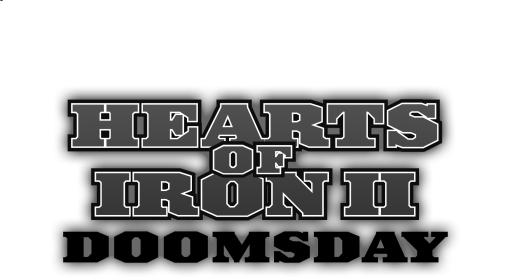


HEARTS OF IRON DOOMSDAY
Paradox Interactive
President and CEO: Theodore Bergqvist Producer: Johan Andersson Director of Publishing:
Fredrik W. Lindgren CFO: Lena Eriksson Programming: Pontus Åberg, Stefan Johansson
Artist: Dick Sjöström Art Director: Stefan Thulin AI Scripting: David Martinez Campaign Design: Simon Aistleitner Marketing and PR Director: Susana Meza Product Manager:
Jeanette Bauer Quality Assurance: Florian Santer Manual: Chris Stone Editing: Ryan Newman, Nick Stewart Original Music: Andreas Waldetoft Sound Effects: Wave Generation
Market coordination
USA: Reena Miranda, Karen Sosa
Germany, Austria and Switzerland: Mario Gerhold, Susanna Mittermaier,
Ute Palmer
UK: Stuart Chiplin, Dean Punter, Holly Groves, Debbie Brettel
PR UK: Simon Callaghan
Italy: Marco Viciani, Daniele Falcone
Scandinavia: Niklas Molin, Lennart Blixt
Thanks to our partners Atari (USA), Snowball (Russia), Friendware (Spain), Cenega (Poland) and Koch Media (UK, Germany, Italy).
Special thanks to all our forum members, partners and supporters, who are integral for our success.

HEARTS OF IRON DOOMSDAY
Introduction
Hearts of Iron II - Doomsday is a stand-alone expansion to Paradox Entertainment’s award-winning Hearts of Iron II, a game where you will guide your nation to glorious victory or ignominious defeat in the World War II era, and as a result of this expansion, through a subsequent hypothetical “Doomsday” conflict between the emerging post-war super-powers. With several Grand Campaigns, numerous Battle Scenarios, multiplayer capability, and your choice of the more than 70 playable countries that spanned the globe at the time, Hearts of Iron IIDoomsday will give you countless hours of challenge and entertainment.
This is a highly complex grand strategy game, not a historical simulation or FPS. With HoI2’s nearly limitless options and exceptional depth comes a comparable learning curve. It may take some time to become familiar with its richness and its multitude of controls, so don’t be surprised if your first few campaigns end in disaster. There is no “right” or “wrong” way to play HoI2, and no sure way to win. You’ll probably find that the lessons you learn in your early defeats will be just as valuable as any that you later gain through victory. Use those experiences and don’t be afraid to experiment or save the game and then try a variety of alternatives.
While this manual will familiarise you with most of the ins and outs of Hearts of Iron II, the most valuable resource of all are the Paradox public forums (www.paradoxplaza.com/forums). There, you can usually find the answer to any question you might have about the game in a matter of hours, if not minutes. It’s also a place where tips and strategies are exchanged, where people from around the world will arrange multiplayer games, where you can read about others’ HoI2 experiences or post your own, and where new battle scenarios and user game modifications will often be developed. This is also where you’ll find Paradox’s latest post-release enhancements available for download as well as a large number of FAQs and other resources.
Installation
System Requirements
To play Hearts of Iron IIDoomsday your system must meet the following requirements:
/ Pentium III 450MHz (800MHz or better recommended) / Windows® 98/ME/2000/XP / 128Mb RAM (512Mb or more is highly recommended) / 900Mb free hard drive space / 4Mb Video Card DirectX compatible (8Mb or more recommended) / DirectX compatible sound card / DirectX9.0 or higher (included on the CD).
Installation Procedure
Place the Hearts of Iron IIDoomsday CD in your CD-ROM drive. If you have AutoPlay enabled on this drive, the installation screen will appear automatically. If the AutoPlay doesn’t start - or is disabled for this drive - then click Start>Run and then type X:\Setup.exe to launch the installation program (replace “X” with the drive designation for the CD-ROM in which you placed the Hearts of Iron II CD, which is usually D or E on most systems). Simply follow the on-screen prompts to install the game.
Keeping Up To Date
Paradox is deeply committed to its customers, and in my experience, their product support is almost unparalleled in the gaming industry. The developers read and frequently participate in the discussions on the public forums and will often implement some of the best player-requested features or enhancements post-release. They also make minor tweaks or alterations to existing features and squish the occasional bug that had previously escaped detection. You can go directly to the downloads page at www.paradoxplaza.com/downloads. asp under the HoI2 - Doomsday heading or visit the thriving community at www.paradoxplaza.com under the HoI2 heading.

HEARTS OF IRON DOOMSDAY
Getting Started
Launching the Game
Click Start>Program Files>Paradox Entertainment>Hearts of Iron 2>HoI2 to launch Hearts of Iron II’s opening movie. Like most Paradox titles, HoI2 tends to launch a little more slowly than some games because Paradox leaves a large number of files in simple text format to make them easily modifiable by users who might want to tweak unit values, write their own events, or even construct new battle scenarios on their own. This gives the game immense flexibility, but it also means that those files must be compiled when the game loads.
For Beginning Players
If you’re new to Hearts of Iron and Paradox games, I would recommend that you begin by reading the next section - Key Concepts - and then work your way through the game’s tutorials. These will introduce you to the most important parts of the interface and get you up and running fairly quickly, though they focus mostly on “how” to do something, not “why”. Once you’re more comfortable and have done a bit of your own experimentation, you’ll probably want to come back to the other sections where you will find detailed descriptions of all the controls and some of the underlying strategies and tips.
My best advice would be a mixture of “don’t panic” and “be patient”. HoI2 can seem a bit intimidating and complex at first, but once you’ve played it for a little while, you’ll find that most of its aspects are quite intuitive. Remember that a full grand campaign game is quite lengthy and that if you rush headlong into battle without proper preparation, you’re likely to be as successful as you would be if you were to try to do it in real life. If you can’t find the answer to a question you have in this manual, don’t forget that you can probably get one almost immediately on (yep, you guessed it) the Paradox public forums.
For HoI2 Players…What’s New?
If you’re a Hearts of Iron II vet, then you’ll find that HoI2 - Doomsday is based on the same engine but with an extended timeline that now extends to 1953. New features include an expanded technology tree that allows construction of helicopter squads, escort carriers and tactical nuclear weapons; a whole new game element of spying and espionage; a hypothetical World War III campaign and several new or revised scenarios; a comprehensive scenario editor…and much, much, much, much, much more!
Key Concepts
As I said in the introduction, Hearts of Iron 2 is a game of considerable complexity. It is vital to understand that virtually every aspect of the game is interconnected. It can and will take time to learn how each of the game elements interacts with each other, and to gain a comfortable degree of control over the nation you are playing. The goal of this section is to give you a broad overview of HoI2’s major components and key concepts before moving on to the subsequent sections that detail each feature and interface in turn.
Fighting the Second World War - indeed, almost every war in history - was not purely a matter of pitting man against man on the field of battle, nor is HoI2 merely a large digital battlefield. Simply fielding a larger army than your enemy will not ensure victory, and neglecting your economy, the so-called “engine of war”, can imperil your chances for survival. It is vital, then, to ensure that your nation has the necessary economic infrastructure and political wherewithal to stand against your enemies if attacked, or to support any aggressive moves you might wish to make.

HEARTS OF IRON DOOMSDAY
A huge army might appear invincible at first glance, but it can easily succumb to a seemingly weaker force that is equipped with more modern weapons, is in better supply, or is superbly trained and led. Elite forces can tip the balance in a conflict, as can employing a strategy that uses terrain or weather to your advantage. Your ability to coordinate every element of your armed forces against your enemy will also greatly increase your chances of winning. Armies may be held in reserve or can be used to support other actions; air forces may be used to soften up an enemy’s defences, disrupt his troops’ organisation, hamper his supply, or even gut his industry; and navies can actively patrol enemy waters to embargo the import of much-needed resources or even bombard and invade his shores.
The Doomsday expansion has added a further wrinkle to the game: an active spying and espionage system that will allow a nation to engage in clandestine activities to weaken an enemy, steal its technological secrets, and to provide information about its force composition, capabilities and strengths. Ignore such subversive actions at your own peril!
Victory
The ultimate goal of Hearts of Iron II is to guide your nation to victory. For those who play a conventional game, there are a number of provinces located around the globe that have a victory point value, and there are the three main political factions: the Axis, the Allies, and the Comintern. Each campaign game has a predetermined end date, usually December 30th, 1953, and the victor is the faction which controls the highest point total worth of provinces when the scenario ends. The shorter battle scenarios may have somewhat different victory conditions, while the Doomsday campaign encompasses the post-war years and begins after the Axis defeat. Although this is the only measure of victory recognised by the game, you might wish to consider alternate “personal achievement” criteria if you choose to play a “doomed” nation, or a country that is not a member of one of the factions and remains aloof. If you are participating in a multiplayer game where it is likely that there will be more than one player on the victorious side, you may want to establish some “house rules” about victory. The choice is yours.
The Engine of War
While HoI2 is undeniably a game that focuses on war, it is not exclusively about war. Conflict is very costly and can involve immense expenditures in resources and lives before a victor is declared. The engine that propels a nation through war and ultimately leads to its success or failure is its capacity for industrial production, and it is frequently for economic or geopolitical reasons that wars are waged in the first place.
Natural Resources
If your economy is the engine that will propel you through war, then natural resources are the fuel that powers the engine. Although there were hundreds of resources that historically played key roles, HoI2 distils them into four distinct categories: energy sources, metals, oil, and rare materials. Energy, metal and rare materials are used on a daily basis by your factories to provide you with industrial capacity (see below), while oil is consumed by many of your armed forces (the navy, air force, and motorised parts of the army) in order to remain operational.
Natural resources are either drawn from provinces that are under your nation’s control, or are acquired via trade or direct cash purchases from other nations should you lack territories where they occur naturally. Any excesses you have may be stockpiled, sold or traded to other nations who are in need. If you lack any of these, then your economy and your military will grind to a halt, most likely dooming your nation to failure.

HEARTS OF IRON DOOMSDAY
Industrial Capacity
To continue our analogy, industrial capacity (abbreviated throughout as “IC”) is the engine that drives your nation’s economy. This represents your overall ability to manufacture goods and is determined by the number of factories that you have operating in your nation. The more factories you have, the greater your potential industrial capacity. Your IC should be thought of as an ability and not as a thing. You can’t store ICs in the way that can stockpile natural resources. You can only use them to manufacture products, up to your daily capacity limit.
Factories require natural resources in order to operate. In HoI2, this is abstracted such that each factory withdraws energy, metal and rare materials from your stockpiles each day in order to run at full capacity and generate IC. If resources are plentiful, your factories will generate their full potential IC. If you run short of a necessary resource, some of your factories will begin to shut down until you can find a new supply, usually through purchase or trade, or through conquest. Running out of a resource altogether is almost certain to doom your nation unless you can resolve the situation quite rapidly, so you may wish to consider controlling your rate of resource consumption by artificially capping your production during plentiful periods. However, shortages of fuel may be alleviated by converting some of your energy stockpile into oil, but this is a very inefficient process unless you have researched advanced technologies to improve the conversion rate.
IC Allocation, Production and Gearing Bonuses
Resources are consumed by factories, who in turn generate the IC you require to manufacture the various things that you will need in the game. You will often lack sufficient capacity to do everything you want to, so you must decide how to carefully allocate whatever amount you have. IC is used by the assembly lines that manufacture your tanks, warships and airplanes. It produces the ammunition and supplies needed to equip and maintain your troops. It is also used to upgrade your existing armies and to make the various consumer goods needed to keep your population happy. A country that lacks sufficient IC will soon find its forces in disarray and its population in revolt. A country with surplus IC can convert this into cash which you can use to fund research, purchase natural resources, or to conduct certain other types of foreign diplomacy and clandestine operations…or to stockpile supplies and prepare for war. Excess IC can also be left voluntarily unused, which conserves natural resources that might be required in the future.
A steady flow of resources and a healthy complement of factories will be vital to your success, but, as you’d expect, this may not be quite as simple to achieve as you might like. Some resources may have to be imported from your distant territorial holdings or obtained through trade with other countries. Your imports will be at risk if your enemy conquers your source or actively engages in blockade and embargo activities. Further, your industry may be subjected to a bombing campaign if you lack control of the skies, resulting in the destruction of factories and a drop in available capacity.
An additional consideration when deciding how to allocate IC will be whether to take advantage of a possible gearing bonus. This reflects the efficiencies of scale that are achieved through the production of many identical items over a longer period of time, but it lacks some of the flexibility and easy modernisation of a more generalised approach to manufacturing.
Infrastructure
Without the necessary infrastructure of roads and railways, it is difficult to efficiently move men and equipment throughout your nation. Factories may only be built in provinces that have enough existing infrastructure to deliver the necessary raw resources and then to transport the finished goods away from them, and the construction rates for some provincial assets are greatly accelerated by higher levels of infrastructure. Your armed forces will require these same assets to assist their movement and to efficiently bring supplies and fuel

HEARTS OF IRON DOOMSDAY
from regional depots to the forces on the front lines. If you have insufficient infrastructure due to poor planning or because it is reduced by an enemy’s campaign against you, then your troops will slow to a crawl and run short of supplies, which will greatly reduce your combat capabilities and increase your rate of attrition (loss of troops and equipment due to illness, mechanical breakdowns, etc.).
Domestic Policies and Government
While HoI2 places you in supreme command, it would be impossible for you to govern every single aspect of your country. Instead, each nation has a set of domestic policies that determine what type of government is in place, what its trade practices might be, what type of army it will field, and how large a say the government permits its population in its affairs. Democracies in particular have strict limitations on the diplomatic actions they may take without provocation.
Domestic policies have numerous effects in the game, the most prominent of these being that they determine who will govern your nation and who will serve in your “cabinet” to attend to the myriad of little details that need taking care of on a day-to-day basis. They are not advisors in that they don’t make suggestions to you as you play, but their individual characteristics will accord bonuses or penalties to your actions. Some may be adept at foreign relations, others may provide a boost to your economy, while still others may champion military doctrines that will benefit your armed forces in certain ways. Domestic policies also have individual effects that may affect your industry, recruitment, public sentiment, intelligence activities, and foreign interactions.
You will begin the game with a set of domestic policies that reflects your selected nation’s historical situation at the time. During play, you may periodically make minor adjustments to your policies, which could result in some changes to your government and the people that serve on your cabinet. However, you are generally prohibited from making drastic or rapid policy reversals except through a few very special circumstances.
Dissent and Partisans
Depending on your domestic policies, your population may also play a prominent role in determining what actions you may take, even to the point of making it impossible to declare war on a nation unless public opinion is on your side. Policy settings will also influence the public’s demand for consumer goods, and failing to meet these demands will have negative consequences by increasing dissent, which represents the population’s overall level of unhappiness. Dissent has three significant impacts: it will cause your troops to fight more poorly; it will reduce your industrial capacity; and it will greatly increase the likelihood of your public rising in open rebellion against you. You can control dissent by reducing it or at least mitigating it somewhat by allocating a larger share of your IC to the manufacture of consumer goods, though this will reduce your ability to meet the production and supply demands of your military. Providing excesses of consumer goods will reduce dissent, while falling short in this area will cause dissent to increase. Dissent will also increase in response to shortfalls in military supply. You will need to maintain a careful balance between the needs of your military and the happiness of your subjects throughout the game.
Captive populations (the people who live in foreign provinces that you occupy) will be much less interested in working for you and are far more likely to rebel than ones who feel that they naturally belong under your rule. Partisans (nationalists who remain loyal to their former government and oppose your occupation) will reduce a province’s industrial capacity and supply efficiency and may also become openly militant if you fail to maintain sufficient forces to keep them under control. An alternative to maintaining rigid military control is to voluntarily grant partisans their freedom, allowing them to form a new nation and establish a government of their own. You will lose the majority of the economic benefits from provinces they are granted, but they will generally be friendly towards you if you allow them their sovereignty; conversely, if they achieve freedom on their own, you will lose all economic benefits and the fledging nation will actively side with your enemies and seek to destroy you.

HEARTS OF IRON DOOMSDAY
Diplomacy and Trade
International diplomacy will also be a significant component of your success. There are many diplomatic options available to you, including negotiating one-time exchanges of goods, arranging open-ended trade agreements, forming alliances or declaring war, and your ability to do any of these will depend on the type of relationship you have with the nation involved. HoI2 keeps track of evolving international relationships on which many of its actions or its willingness to agree to diplomatic proposals are based. Fortunately, you have some diplomatic options available to you that will help you to improve your relationship with other countries, although any hostile actions you make will tend to undermine these efforts.
It’s rare that a nation can stand alone against the world, so you will probably wish to be part of an alliance. Although limited alliances are possible between almost any two or more nations, HoI2 considers the three main historical factions to be of paramount importance: the Axis (led by Germany), the Allies (led by the United Kingdom) and the Comintern (led by the Soviet Union). Depending on the historical situation, some nations will begin the campaign or scenario already a member of an alliance, while others will be neutral. As the game progresses, the factions may attempt to influence other nations to join their alliance, or neutral countries may even petition to join an alliance if they have a good relationship with its members. Alliances may freely move forces and trace supplies through the territories of their member nations. They will frequently supply friendly forces and can lend divisions or even entire armies to an ally when the situation warrants that they be under their control. Neutral territories must be respected at all times, meaning that movement and the tracing of supply is prohibited unless you can negotiate military access for your troops with that nation’s government.
The other major diplomatic activity you will conduct is trade. You will probably establish a number of openended trade agreements where you will exchange resources, cash or goods with other countries on a daily basis in order to meet your respective industrial needs. You can also negotiate one-time deals of this nature, or more complex trades that involve the exchange or purchase of land or even technological blueprints. You are also able to simply donate resources, land, blueprints or even equipment to another nation if you wish.
The success or failure of your diplomatic attempts will depend on the domestic policies, cabinets, political leanings and size of the two nations involved. It will also vary with the attractiveness of a proposal and the relationship that exists between them. Not surprisingly, the more harmonious two nations are, the more likely it is that an offer will be accepted and the more balanced a deal they may be willing to negotiate. Successful diplomacy can even be its own reward, since each successful effort will usually improve your relationship.
Intelligence
The Doomsday expansion has added another key ingredient to the mix: the ability to wage a clandestine war where spies may be sent to other nations to engage in a variety of operations. These include stealing technological blueprints, assassinating another nation’s ministers, engineering a foreign coup, influencing the global opinion of that nation, sabotaging a nation’s production or research, fomenting dissent, and to create and support partisan activities. If that nation has a nuclear arsenal you may also instruct your spies to try to destroy those dangerous weapons.
Spies and associated intelligence technologies also provide vital information about the other nations around the globe that would otherwise remain hidden. In order to evaluate the chances of launching a successful campaign against an enemy, you should consider it essential to first determine the capabilities of its military, technology and industry. Similarly, you should devote some resources to ferreting out your enemies’ spies to prevent any similar activities within your own nation. Success or failure could easily tip the scales in any subsequent conventional conflict.

HEARTS OF IRON DOOMSDAY
Technology
Another key domestic activity you will engage in is the research of new technologies. Some of these will improve your industrial capabilities, but the majority of advances are designed to enhance various elements of your armed forces. You may discover superior military doctrines, better arms and armaments, larger tanks and naval vessels, advanced aircraft with greater range, or more subtle advances such as systems that allow better observation of enemy movements or detection of their forces. You may even decide to pursue and deploy atomic weaponry. Needless to say, falling behind in the arms race is not likely to be a good idea, unless you can meet your enemy with overwhelming force, and even then, victory is not assured.
Research is conducted by funding teams of scientists to work on research projects. The number of projects you can conduct simultaneously will depend on your overall IC (a large nation can have as many as five projects ongoing at a time), and the nation that you select will determine the variety and calibre of your available teams. You will need to assign teams to your projects with some care, since each team will usually have a skill level and certain areas of expertise associated with it. One that excels at avionics, for instance, can be expected to produce positive results in a new aircraft design far more rapidly than it would if you asked it to work on finding a better hull for your submarines. The length of time it will take to research a project depends on your teams’ abilities, their overall skill level, the project’s complexity, and your ability to maintain a steady flow of funding to the team.
Once you have achieved a new level of technology, you will need to implement it. In most cases, existing equipment can be improved by allocating IC to its upgrade. Major breakthroughs for technologies that haven’t previously existed as well as significant naval model upgrades must be manufactured from scratch. You have the option to keep as much obsolescent equipment in the field as you like, although you may also choose to upgrade it or scrap it to recoup some of its manpower.
Preparation and Support of the Military
There are many components that must fall into place for a campaign to be successful. Armed forces must have access to a continuous flow of supplies and ammunition if they are to remain in fighting form, and they will need strong and capable leaders who are able to command them effectively while maintaining an overall level of discipline and organisation. Factors such as terrain, weather, and the placement of defensive structures will greatly influence their performance, as will their previous experience in such combat situations.
Supply, Outfitting and Transport Capacity
Your ability to supply, outfit and transport your troops will be vital to your military success. Armies require ammunition and food (supplies) to fight. Motorized vehicles, aircraft and naval vessels will also need fuel (oil) if they are to remain operational. For overseas engagements, you will also need to be able to move men and equipment great distances that are too far or impossible to reach by normal means. Failure to supply your forces will not only result in a reduction of their operational capabilities but will also increase your level of public dissent
You will need to heed and maintain your supply chains to avoid having your armies end up in disarray and unable to fight. Supplies are manufactured by allocating IC to their production and then are transported to your forces along your supply chains. This can involve ground supply (using your provincial infrastructure), naval supply (via convoys), air supply (via your airborne transports), or a combination of these, all of which can also be disrupted by enemy actions. If your supply chains are damaged or cut by the enemy, or if you lack sufficient oil and supplies for your military, your chances of survival are exceedingly slim.
There is also the issue of transport capacity to consider. This reflects the infrastructure such as roads, railways and such that are in place to move large volumes of materials and men in a reasonable period of time. Each
10

HEARTS OF IRON DOOMSDAY
province has an infrastructure level which you can increase that will limit this volume and can be damaged or otherwise diminished by enemy aerial bombardment. Sea supply demands that you devote enough convoys to the task and have an available port to offload those supplies. If those convoys are left undefended, they can quickly fall prey to enemy submarines, surface vessels and even aerial bombardment, so you will need to provide escorts or other protection for them as well. Airborne supply tends to be very tricky and not particularly efficient because the capacity of the aircraft is limited, they require fuel to operate, and unless you assign them some protection, your enemy’s fighters will probably shoot them out of the skies faster than you can replace them. Nevertheless, this is a method of keeping your troops alive until you can find an alternate means of getting resources to them.
Don’t be surprised to find an enemy actively engaged in disrupting your supply, particularly if he enjoys naval or aerial supremacy. Of course, you can employ similar tactics, disrupting his supply and encircling his troops to devastating effect.
Organisation and Entrenchment
Land forces that are constantly moving don’t have much time to prepare themselves against an enemy attack and have a tendency to become somewhat “stretched out” or disorganised. The same is true of armies that are constantly subjected to naval barrages or aerial bombardment. HoI2 models this aspect of war using the concepts of organisation and entrenchment.
Organisation is a measure of the cohesiveness of a force, which is a representation of how able it is to receive and respond to orders, how well it is supplied, how competently and thoroughly its command structure has been established, and is also an indicator of its general morale. Each of your units, be they land, naval or air, must have a sufficient level of organisation to engage in battle, and without it they will break and retreat in disarray. A force that is engaged in combat will begin to lose organisation, and the longer it continues to fight, the greater the loss will be. The addition of new recruits to replace casualties will also reduce organisation proportionally to the number of newcomers added, and if a unit finds itself without a source of supply, then organisation will plummet rapidly.
While moving, a unit’s organisation will usually remain static unless the terrain it is traveling through cannot support the size of the force, or if it is moving without supply. If it ceases its movement and avoids battle for a while, then its organisation will gradually recover. The maximum organisation is determined by its leadership and experience (see below) and can also be increased through the research of various combat doctrines and equipment advances.
A land unit that is stationary for a time will also begin to entrench itself in a province by selecting the most defensible ground, preparing foxholes and snipers’ nests, establishing command and aid stations, organising munitions, and so on. This will give the unit a bonus in any subsequent defence of that province and can make it difficult to overcome without a concerted effort on the part of an attacker. The longer a force remains in place, the more “dug in” it will become. However, this entrenchment bonus is immediately lost if the unit moves, and even if it later returns to the province, it must begin the process from scratch.
Command, Leadership and Experience
The effectiveness of a force relies heavily on its combat experience and on the officers that you assign to your front-line commands. Each time a unit engages in battle, it will gain some valuable combat experience and through the course of time and repeated conflict, it will begin performing noticeably better. The resulting veteran units may become the backbone of your armed forces, but as they suffer casualties, their losses will be replenished with green recruits which, not surprisingly, dilutes their effectiveness.
Individual units may be instructed to act independently, but most often you will wish to group them into larger forces, often using a mixture of unit types to achieve the desired overall balance and combat effective-
11

HEARTS OF IRON DOOMSDAY
ness. Commanding larger numbers of units requires special leadership skills that are possessed by only a handful of people, so you will need to draw from a pool of your officers, assigning someone to lead each of your forces. Various officers will have different skills or areas of expertise, so selecting the right man for the job can be extremely beneficial. Each officer also has his own level of combat experience which will increase as you continue to employ him. You may find that at some point you may wish to promote him to an even higher rank in your military, increasing the number of individual units he can command without incurring a penalty. Junior ranked officers tend to accumulate experience more rapidly than senior ones however, so this will often prove to be something of a balancing act.
Very large-scale operations bring an added level of complexity to the overall command. It is one thing to issue orders to a collection of divisions all occupying the same general location, but another thing entirely to manage multiple army groups, whole armies, or even multiple armies assembled along a front. In such instances, you will likely need to establish special headquarters divisions, a unit unsuitable for direct combat which improves the overall supply efficiency of large numbers of forces and gives them a greater likelihood of achieving positive results. When you are considering massive offensives or the defence of an entire front, this special division can have a dramatic effect on the overall success of your operations.
In a larger sense, however, you will always be in ultimate control of your military and it will be up to you to plan your attacks and arrange for suitable defence of your territories. HoI2 includes some handy features that make it as easy as possible to coordinate your forces and use them to maximum effect, and to assign long-term missions that your officers will then proceed to carry out unless you instruct them to do otherwise. Leadership and experience simply help to determine how effective they will be in fulfilling your orders.
Defences and Fortifications
While armed forces are required to protect your territories from the enemy’s advances, there are up to three different defence installations that you may be able to construct to help improve your chances of defeating an assault. If you have the required technology, you can also build radar sites to improve the effectiveness of your aerial defences.
The construction of defences requires a commitment of IC until their production is complete. They can be damaged by enemy attacks, requiring further allocation of resources to repair them, and they can be captured and used against you if they fall into enemy hands. Each of these installations can be enhanced through further IC investment, thereby increasing their size, quality and effectiveness. This is a worthwhile investment and can become the difference between successfully warding off an enemy’s assault and succumbing to his advance. Land fortifications are a network of bunkers, gun emplacements and minefields that you can construct in a province to help your army repel enemy land forces. They are particularly effective in protecting your infantry from tanks, mechanized units and artillery forces where they might otherwise be overrun or destroyed. They also offer some shelter from aerial bombardment although they are not designed to actively counter such attacks. A land fortification offers no resistance by itself and must be manned to have any effect.
Entrenchment bonuses are combined with land fortification bonuses, resulting in an almost insurmountable defence if a force remains stationary for long enough in a province that has been heavily fortified. A good example of this would be the French Maginot line at the onset of the war, an obstacle that the German high command wisely chose not to approach with a frontal assault. The only methods of dealing with forces that are stationed at such a defence are to bombard them over a long period of time, cut off their supply and hope to starve them into submission, or to take your admittedly poor chances with a series of massive successive assaults on their position. Should they be available to you, paratroopers will bypass defensive fortifications and may be an effective component in an assault, although they incur other penalties and are usually fairly lightly armed. Needless to say, your best bet is to use a combination of all of these strategies whenever possible.
12

HEARTS OF IRON DOOMSDAY
Coastal fortifications are a similar series of trenches, gun emplacements and other devices constructed along the shoreline of a province and must also be manned by your troops if they are to have any effect. They will present a major obstacle to enemy troops attempting to land in the area. Even an elite marine unit will find it hard to break through to establish a beachhead.
Anti-aircraft guns offer a third possible means of defence. Unlike land and coastal fortifications, anti-aircraft guns do not need to be manned by your forces in order to operate, as their construction includes a manpower component. Their function is to provide added defence against air missions flown against targets in the province and to disrupt any enemy aircraft that pass overhead. They will not in any way help to defend you against the assault of a ground force or naval invasion. Enemy aerial attacks against factories, infrastructure, bases, other fortifications, or any forces stationed in that province will be subjected to withering return fire from your anti-aircraft batteries. This will not only hamper the inbound flight’s organization, thus reducing the impact and extent of the damage from the attack, but it will also most likely inflict a number of casualties as well. Enemy squadrons whose missions require that they fly through the region will also be subjected to fire, although to somewhat lesser effect.
If you have researched the necessary technologies, you will also be able to build radar sites in your territories. These stations will greatly improve any aerial defence that you mount in that province against enemy bombers and fighters, and may also allow you to detect approaching enemy naval vessels and aircraft in an adjacent sea zone. Radar sites do not need to be manned by your troops to be operational.
Naval and Air Basing
Military vessels and aircraft usually have special requirements that necessitate the construction of dedicated port facilities and air fields to fully meet their needs. Hearts of Iron II simulates this by using a system called basing.
Each squadron must be assigned to an air base that is located in a province that you control or that is friendly to your forces, and all operations that it conducts must be launched from that base, to which it will return after the mission has been flown. If you assign too many air wings to too small a base, then you may find that the ground staff will have trouble maintaining and servicing all of those aircraft in a reasonable period of time. You can either enlarge the base to increase its capacity to a predetermined maximum size, or reassign some of the squadrons to a different base that has sufficient space for them. If there isn’t a suitable location, you can also construct a new base to house them, although this will take some time to prepare.
Similarly, naval bases are needed to act as home ports for your fleets. Ships are assigned to them and must return periodically to conduct minor - or not so minor - repairs. Any number of ships may use the same naval base, although a base’s size determines how rapidly it can repair those vessels, and its location will affect what seas your navies will be able to patrol. Existing naval bases can be enlarged with certain restrictions, and new ones can be built. There are also many provincial ports that your fleets may use as temporary moorings; however, those harbours lack the facilities to carry out any repairs or offer supply to your vessels.
Bases are susceptible to bombardment and can fall into enemy hands. Enemy aircraft can be given missions to strike at your ports or crater your runways, reducing their basing capacity and forcing you to spend time and resources to repair them. If you lose control of a province that contains a base, then any forces that used it as “home” will find themselves out of supply and forced to rebase. What’s more, your foe will be able to use the captured facility as a new base for his forces, once he has effected repairs to the inevitable damage it sustains during its capture. You should pay close attention to the locations of your enemy’s bases and either render them inoperative or consider attempting their capture, while taking precautions to prevent the enemy from doing the same to yours.
13

HEARTS OF IRON DOOMSDAY
Weather, Terrain and Time of Day
Weather and terrain played significant roles in the outcomes of historical military operations. It was the onset of winter that did much to halt the initial German advance into Russia in 1941, and it was Burma’s inhospitable terrain that added a heavy toll to the loss of life in that region. Most military actions also had to be conducted during daylight hours, since target recognition was very poor in an era when human eyesight was more or less the only available instrument. All three conditions are taken into consideration in Hearts of Iron II.
Weather is synthesized in-game according to a complex random model and will play a prominent role in your games. Both rain and snow will have a negative effect on your military operations, reducing units’ combat effectiveness, quite significantly in some cases. Combat resolution also includes a “visibility” component which adverse conditions will reduce, unless specialised equipment has been discovered by your scientists and supplied to your forces.
Certain types of terrain will also reduce movement speeds, hamper supply, and impose penalties to combat. The effect will vary depending on the unit type, generally impacting more severely on motorised units than on foot soldiers, and in most cases the terrain will give a defender an advantage, reflecting his ability to make strategic defensive use of the landscape.
Hearts of Iron II is played on a global stage over a period of years and includes accurate modelling for both local time of day and for seasonal variations in the length of a region’s daylight hours. Most units perform very poorly in the hours between dusk and dawn when visibility is poor, so you will need to take this into consideration when planning your attacks. Certain technological advances may mitigate this somewhat, but you will probably have better success if you plan your large-scale operations to begin shortly after dawn during seasons when the daylight hours are long.
Combat
Hearts of Iron 2 does not seek to model combat on a highly detailed, microscopic level. You do not control individual soldiers, squads, platoons, companies or even battalions. In HoI2, you will issue orders to divisions or whole armies, and your battles will represent a contest for the control of much larger regions of land such as provinces rather than individual beachheads or buildings. The actual hand-to-hand fighting occurs behind the scenes in your CPU and your progress is displayed using graphic and numeric feedback as combat ensues.
Movement is Attack for Land Battles
A significant change in actual battle mechanics was introduced in Hearts of Iron II. In previous Paradox games - and many other strategy games, for that matter - a land force would be ordered to engage an enemy in a neighbouring province, move there, and then upon its arrival, combat between the two would ensue. The loser would then retreat from the province and the victor would remain. This is not the case in HoI2. Instead, the game employs the concept of “movement is attack” in all land-based battles.
Combat is initiated as soon as a land force begins to move towards an enemy province that is being defended. The battle will rage on until one of the sides has gained the upper hand, at which point either the aggressor’s movement is discontinued if it loses, or the defending force begins to withdraw and the victorious attacker concludes its movement into the province and assumes control. This system alleviates a number of common issues such as being unable to tell where an enemy unit is moving until it is too late, and also offers a number of new operational possibilities for both the attacker and the defender. Forces in adjacent provinces may support the armies involved in the battle, and behind-the-lines reserves may be positioned to make a last-ditch effort to shore up the defences. Air and naval battles, however, do not use this combat method and will contest an air or sea zone while jointly occupying it.
14

HEARTS OF IRON DOOMSDAY
Orders
If you play a larger nation, you will find that the sheer number and geographic separation of the forces you field can make them daunting to manage. To reduce the micromanagement requirements and allow you to focus on the zones of greatest activity, HoI2 permits you to give standing orders to most units. When you are initiating a large-scale assault involving large numbers of units or a combination of land, naval and air forces, you will also need to carefully coordinate these attacks to achieve maximum effect. The game’s order interface makes this surprisingly easy to achieve.
Each unit has a useful set of orders that may be given to it beyond the basic “move here” or “attack right now” commands. Depending on the unit type, an available option is selected on the order interface and the force will then carry out the orders exactly as you have instructed. The specific options are detailed later in the manual, but the concept that you should understand is that the order interface includes the ability to set a date and time that you would like a force to begin an action, allowing you to coordinate the orders of multiple units. In many cases, you will also be able to set a date and time or operational condition for it to discontinue operations, or even give a unit a set of standing orders to repeat the same mission multiple times, allowing you to focus your attention elsewhere while it goes about its business.
Air and Naval Combat
Air and naval operations do exist, of course, but are abstracted to a large degree in Hearts of Iron II; otherwise, the added level of complexity would be overwhelming to most players. You will usually assign general orders to each air wing or flotilla, giving specific time period and other parameters that you would like it to follow, and you may then essentially leave it to its own devices to carry out these operations until it receives new ones or the orders expire.
Game Options
Difficulty: There are 5 levels of difficulty which apply global modifiers to most aspects of the game, such as industry, resources, combat, movement, and more. At easy and very easy levels, the AI nations will be handicapped and the player will be given artificial bonuses. At hard and very hard levels, the reverse is true. You can see and even change the precise modifiers used by looking at the difficulty.csv file in the db folder.
A.I. Aggressiveness: This adjusts how the A.I. reacts to the player’s actions during the game, ranging from “coward” to “furious”. At furious level, the AI will tend to declare war at the slightest provocation and will be considerably more actively militaristic, while at coward level the AI will tend to be more conservative and generally defensive.
Game Speed: This can be set prior to starting a game or from within the game itself using the “Ctrl” and “+” or “-” keys. In a multiplayer game, only the host may change the game speed. Share Countries: Change this to “ON” for a multiplayer game where you wish to allow more than one player to be able to select the same country. This option is disabled in single player games. Autosave: This allows you to set how often the game will automatically save, which may be changed from within the game via the options menu. In multiplayer mode, only the host computer will save the game.
Use Counters: By default, HoI2 uses animated sprites to display your units on the map. Enthusiasts may wish to toggle this to “ON” to have units displayed as traditional NATO counter pieces. instead. This can also be done in-game by right-clicking on the “pause” button.
15

HEARTS OF IRON DOOMSDAY
This is not to say that combat won’t occur between these forces; it will, and quite frequently at times. When this occurs, there are special rules that govern the engagements which take the types of units involved into consideration, as well as the time of day and weather conditions. Aerial combat is further limited by the range of the aircraft involved, as they will eventually need to break off and return to base to avoid running out of fuel and ammunition.
It is vital to understand that neither sea zones nor the air space above provinces are subject to control in the way that the provinces themselves are. There is no “ownership” of them, and neither aircraft nor naval vessels are capable of capturing a province. Most often, you will use them in support of your armies, seeking to soften up an enemy’s resistance through bombardment or to hamper or even cut off his lines of supply. Combat between them will therefore most likely be a contest to determine whether you are able to carry out these goals.
The Fog of War
This doesn’t refer to a weather condition, but rather to darkened regions of the map where the game will hide things from you that you aren’t in a position to know - namely, the dispositions of other nations’ armed forces. It is assumed that you will have sufficient reconnaissance and intelligence sources to determine some basic information about provinces, even in your enemy’s territory, but you will be unaware of the location of any forces that don’t belong to you and are outside your territory or beyond the sighting range of your units. You will be aware of enemy units occupying provinces adjacent to your troops, but you will usually have only a very vague idea of their complement and size until you engage them. You may also wish to fly several long-range missions deep into enemy territory prior to an attack in order to gain additional information about possible reinforcements and reserves that the fog of war will otherwise obscure. Keep in mind that some units, particularly submarines, are able to hide their presence, but that there are also technologies you can research to assist you in detecting and identifying them.
Connection Types
You will need either a fast Internet connection (DSL/Cable with TCP/IP protocol installed) or a connection to a Local Area Network (LAN) to play HoI2 in multiplayer mode.
LAN: This connection is established automatically by searching for any hosted games on your LAN. Either click “host” or select a detected game and click “join”.
Valkyrienet: This is a service provided at no charge by Paradox as both a meeting place for players and a connection handler to make it easier to host or join games. HoI2 also allows the host to set a password that guests must enter to be able to join private games.
Internet: You will need to enter the IP address of the host computer in order to join an internet game. This can change each time the host connects to the internet if it is not a permanent connection. If you are hosting a game, you can determine your IP address by establishing an internet connection and then chose Run from your computer’s Start menu.
If you are using Win98 or WinME, type winipcfg and then click OK. Make a note of the IP Address and then communicate it to your guests.
If you are using Win2000 or WinXP, type cmd and then click OK. In the new window that appears, type ipconfig. Make a note of the IP address and then communicate it to your guests.
16

HEARTS OF IRON DOOMSDAY
Routers and Firewalls
It is common for computers to be “behind” routers or be protected by firewalls.
Firewalls: vNet and internet multiplayer games use ports 2300-2400, 28800-29000 and 4740047700 for communication. You will need to make these available to host or join a game. Note that this will result in limited exposure to malicious internet users and that you do so at your own risk. Routers: Since there are many different routers on the market, each with unique software controls, please consult your user manual for details. You will also need to have a network client installed in Windows networking. If you’re having trouble, ask for help in the HoI2 Multiplayer subforum on Paradox’s website.
Known Issue: Please be aware that there is also a known DirectX-related issue that may cause clients to “drop out” of a multiplayer game if both the host and a client are behind a NAT-enabled router and the game is paused for longer than 30 seconds. This issue is unresolvable through game coding, so it is recommended that another (non-NAT) host be chosen, or that any long pauses be avoided (try temporarily reducing the game speed to a crawl instead).
The Doomsday expansion has further extended the fog of war to reduce the certainty of your knowledge of more general information, such as the total forces or technological position of any nation that is not part of the same alliance. Fortunately, your allies will share all of their intelligence and force dispositions with you as well.
Strategic Redeployment and the Force Pool
Any new military units you produce will enter your force pool and can then be deployed at your discretion to any valid location. Naval forces and air forces have an additional deployment prerequisite: they must be assigned to specialised bases that are constructed to house and support them. These bases are limited in the number of units they can effectively handle, and this number can be temporarily reduced as a result of damage from enemy attacks.
Land units that are already in the field may be temporarily withdrawn from active service and strategically redeployed elsewhere without the need to manage their exact movements. As long as they don’t have to cross water, which requires the use of naval transports and thus active management, they will arrive at their new posting after a period of time. This redeployment method is not possible for naval or air forces, which must be rebased via conventional means.
17
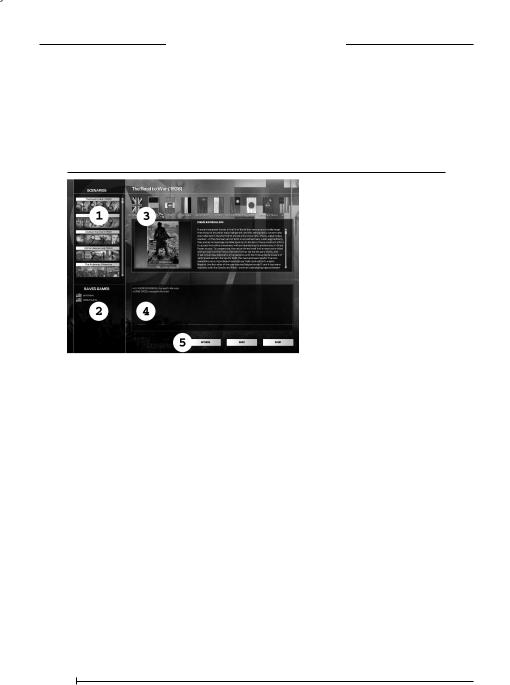
HEARTS OF IRON DOOMSDAY
The Main Menu
To begin playing Hearts of Iron II, click Start > Programs > Paradox Interactive> Hearts of Iron 2 > HoI2 and after a moment or two, the opening movie will play. You will then see a status screen displaying the progress of the main game engine’s loading process, and once this has finished, you will be presented with the Launch Menu. This gives you the options to start a single player game, start a multiplayer game, play the tutorials, view the game credits, or exit the game.
Single Player Games
Most often, you will probably be playing a single player game, pitting your skills against the computer. Click “Single Player” on the Launch Menu and the main menu screen will appear.
Selecting a Scenario or Save Game
When starting a new game, you will select from a list of available grand campaign games or battle scenarios (area 1). Grand campaign games use the entire globe and allow you to play any available nation in the world, starting with each nation’s historical position at a significant
date in WWII and then progressing until the end date in December 1953.
Battle scenarios are usually more limited in scope, focusing on short, specific engagements and often restricting the nations that may be selected and even the part of the globe that can be used. Many of these scenarios disable some of the game’s more complex interfaces, providing the player with only scripted forces, replacements, and resources with which to accomplish their goals, and usually have special victory conditions. The battle scenarios are great for playing fairly short “what if” games around major offensives, or for one-time multiplayer games. For the purposes of this manual, I will assume that you have selected a grand campaign game and that all interfaces are available to you.
Once you have begun play, you can save your game at any time. To load a saved game, simply scroll through the list of file names (area 2) and select the one you wish to resume.
Selecting a Nation
After you have selected a grand campaign, battle scenario or saved game, the nation selection portion of the main menu (area 3) will display up to ten national flags. Click one of these to select that nation and to display a brief overview of its historical situation during that era. If you don’t see the flag of the nation you wish to play, right-click on any of the flags to display a list of additional nations and select the one you want. If you still can’t find the desired nation, then either it doesn’t exist (it has been eliminated from the game due to conquest) or you have selected a battle scenario where that country is not available for play.
Changing the Game Options
At the bottom of the screen (area 5) you will see three buttons. Click the Options button to change the settings to suit your preference (see sidebar). If you make a change, this will be displayed in the log area of the
18

HEARTS OF IRON DOOMSDAY
main menu (area 4). If you don’t change anything, the game will use the same settings as the last time you played or will use the default settings if this is your first game. If you made a mistake and intended to play a multiplayer game or tutorial, you can click the Back button to return to the start menu.
Launching the Game
Once you have selected a country and changed whatever options you wish, click the Start button to begin the game. This button will remain greyed out until you have selected a country.
Multiplayer Games
Multiplayer games are started in much the same way that a single player game is launched; however, there will be at least two additional steps to perform before you may begin play. One player will act as the “host” of the game and the other players will join as “guests”. Up to nineteen additional players may join and I would recommend that the player with the fastest and most stable connection be chosen for internet games, since this has a greater impact on performance than the host’s computer specifications. If connection speeds are equal, then the player who has computer with the best performance should be the host. Only the host may select the scenario or saved game to be played, and only the host may change the game options.
When you click the Multiplayer button on the initial menu, you will be asked to specify the type of connection you wish to use (see sidebar) and to enter your name. Type your name in the space provided and then click the button that corresponds to the connection type you wish to use. Unless you are using Valkyrienet (vNet), you will then be asked whether you wish to host a game or join a game as a guest. Note that all players must be using the same version of the game, though this is checked automatically when the connection is first established in order to ensure that there are no file discrepancies. I also recommend that you disable any nonessential software that might be running in the background on your computer as this will often affect stability. The vNet connection will take you to a free service where players frequently meet to start new games. Since vNet supports all of Paradox’s games, you will need to select the HoI2 channel from the channel listing which will take you to a chat location where you can arrange a new game. Once you’ve found a few people to join, you must designate a host. Since vNet can be busy at times and some people have expressed a desire to be able to create “private” games, HoI2 now allows the host to set a password that must be entered to join a game. Once you’re ready, the person who is hosting will click the Host button and type in a password. The other players will soon see the game listed and should select it, click Join and then type in the password when prompted. The connection will be automatically established by vNet. Note: Once you start the game, the connection is handed off to the host and the game will disappear from the vNet list.
Once you’ve established a connection, the main menu screen will appear, although you will notice a few differences. Saved games will now be found at the end of the scrollable list in the game selection area (area 1) and a listing of all players will now appear in the area at the bottom left of the screen (area 2). I hope that you never need to use it, but the host also has the ability to ban a guest from the game by highlighting the player’s name and clicking the Ban button. On a more positive note, you are also able to chat with other players while viewing this screen by typing in the space below the narrow line in the log area of the screen (area 4).
The host may now select the scenario or saved game to be played. If a saved game is chosen, then there will be a brief pause as the game is compressed and then the transfer process will begin to send the save game file to the other players. You will see a status indicator beside each player’s name, indicating whether the transfer is still in progress or whether it is complete. I strongly advise players to wait until everyone has completed this transfer before selecting countries, since this is a common source of subsequent problems. Most players who frequent vNet follow a protocol whereby all players wait until the host has confirmed that everyone has completed the save game download. The host will then select a nation which signals that it is safe for the guests
19

HEARTS OF IRON DOOMSDAY
Message Settings
HoI2 allows you to customise the way that messages are displayed. Each type of message may be selected and set to display in one of the following ways:
Do Not Display: Use this setting to suppress this message from displaying at all. Display in Log Only: These messages will only display in the history log
Message Notifier: These messages display a small icon on the right side of the screen. Clicking on it opens the message box. (This option is not available for all message types.)
Message Box: This setting is for more important information and will cause messages to appear in a large message box as well as being recorded in the history log.
Message Box with Pause: This setting will bring up a message box and pause the game until you click “okay” on the box. Note that in multiplayer games, the auto-pause function is disabled and this message will simply bring up a message box.
to do so as well. I would also advise against using the Windows operating system’s Alt+Tab ability during the download as this will almost always cause the transfer to freeze or become corrupt. With a decent connection speed, this process shouldn’t take very long and you can safely chat with one another while waiting.
You will notice that the game options submenu now allows you to change the Share Countries setting to “yes”. This allows more than one player to select the same nation, which is otherwise prohibited. If two or more players up to a maximum of ten play the same nation, then each of these players will be able to use any interface or control for that country. There are no limitations, so I would recommend you agree on areas of responsibility ahead of time to prevent disagreements during play.
Once all players have selected their nations, the Start button will become active for the host. When the host clicks this, the scenario or saved game will launch on each system and when all players have finished this process, with slower systems taking longer to complete the launch, the game will begin. Another vNet custom that I recommend for any multiplayer game is for each player to use the chat feature to type “in” or “here” once the game has launched.
You may also chat with one another during the game by pressing the tab key, typing a message, and pressing the enter key. You have the ability to make your chats “private” by selecting the player (or players) you wish to have receive your communications. For your convenience, there are several preset chat filters that allow you to quickly address messages to the people you wish. After you press the enter key, the chat message will display on the recipient’s main game screen and be recorded in his history log.
There are a few other important differences between single player and multiplayer games. The game speed setting may be adjusted during play using the “Ctrl” and “+” or “-” keys, but this may only be done by the host. Any player may pause the game at any time but other players may un-pause it after a delay of 30 seconds. Any message boxes or events that would normally cause the game to pause automatically, depending on your message settings, will display normally but will no longer pause the game. Some of these will expire if you don’t respond to them, disappearing after a period of time. Others will disappear if they are no longer valid.
Tutorials
If you select the Tutorial button in the Launch Menu, you can play the HoI2 tutorials. For more details, see the Tutorial section near the end of the manual.
Credits / Exit
Click on the Credits button in the Launch Menu to see a list of the many people involved in the design,
20
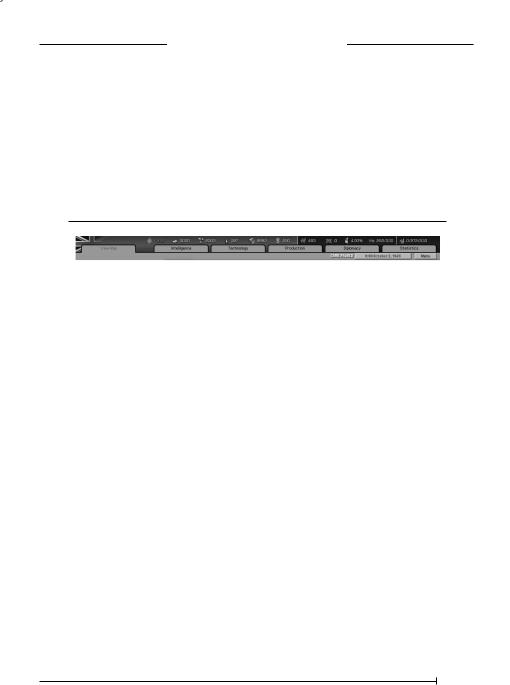
HEARTS OF IRON DOOMSDAY
development, production and beta-testing of Hearts of Iron II - Doomsday. The Exit button will quit the game and return you to your Windows desktop.
The General Interface
There are very few parts of the HoI2 interface that are visible at all times. The majority of your screen will contain a display of context-sensitive information that will change depending on the type of action you are taking. There is one area that never changes, located at the top of the screen. This provides a quick reference to some of the most critical pieces of game information and also gives you access to all of the principal interfaces. There are also a few other things that aren’t directly part of any other interface but have a global impact on the game. Taken together, these are best described as “the General Interface”.
The Top Bar
This is the area at the very top of the screen that is visible at all times and displays a quick overview of the state of your nation. It also gives you access to each of the main, vitally important, interface screens.
Status Overview
The upper portion of the bar shows a series of icons and values to which you will frequently refer. This allows you to quickly review your reserves of energy, metal, rare materials, oil, supplies and cash. It also displays your manpower pool, national dissent level, and your transport and industrial capacities. Hovering your mouse over any of these will reveal an expanding tooltip that gives you a more detailed summary of that item, particularly your daily income and expenditures. If the daily change is a negative one, then the value will be displayed in red. Each item is described in detail in the relevant section of the manual.
The Folder Tabs
Immediately below the status overview is a set of clickable folder tabs that give you access to the six main HoI2 interface screens, which we’ll later discuss one by one in the manual. Everything displayed below the top bar depends on which of these folders you’ve selected.
•View Map: Clicking this folder tab displays the interface that you’ll use most often: the Main Map Folder. This is used to view the map of the world where you’ll find details of your provinces, examine and issue orders to your units, deploy new units, and perform most other common in-game actions.
•Intelligence: This is the Intelligence Folder, where you will recruit new spies, manage their activities, and review whatever intelligence has been collected about other nations’ armed forces and capabilities.
•Technology: This is the Technology Folder, where you will assign specialized teams to begin working on research projects, and where you may review already available technologies and their effects.
•Production: This tab displays the Production Folder, where you control your national budget, initiate the construction of new units and industrial and defensive structures for your provinces, and see a summary of such important things as your current trade agreements, convoys and resource depots.
•Diplomacy: This tab takes you to the Diplomacy Folder, where you may set your domestic policies, conduct diplomacy with other nations, and view diplomatic and political information about the other nations in the world.
•Statistics: This folder provides a set of detailed charts and pie charts, allowing you to view summaries of
21

HEARTS OF IRON DOOMSDAY
almost all of the important information about your nation, armed forces, and the rest of the world. There are some very handy “redundant” interfaces on these pages that allow you to make a number of similar adjustments very rapidly, and many items are hot-linked to allow you to quickly jump to a province or unit on the Main Map without having to search for it or use one of the other methods of locating items.
The Date/Pause Button
The current date and time are displayed in a button at the bottom right of the top bar. The time shown always reflects Greenwich Mean Time (GMT) and, depending on what portion of the map is presently displayed, could be significantly different from the local time. If you click on this button, the game will pause for as long as you wish. Clicking on it again will resume play. You can also press the pause button on your keyboard to pause and resume. Right-clicking on the button will display a menu that allows you to quickly select a new game speed, or to toggle between sprites and counters being displayed in the Main Map folder.
The Game Management Menu Button
Immediately to the right of the date/pause button is a button labelled “Menu”. Clicking this will bring up the Game Management menu where you may select from several options:
•Save: Allows you to save your game in its current state. The default file name will be your country, date and time, but you may change this to whatever you like by simply typing in a new name. Once the save is complete, you will be returned to the game.
•Options: This brings up the in-game options submenu, which is similar to the new game options. Here, you may change the game speed, toggle between sprite icons and counters, change your autosave settings, and adjust your sound effects and music volumes. There is also a box at the bottom of this submenu which allows you to change your message settings.
•Hints: This turns on the hint boxes that are displayed when the game first launches.
•Surrender: This ends your current game session (we all have to sleep sometime). Your current game data is lost when you exit, so make sure you’ve saved first.
•Return: Returns to the game.
Message Boxes
You will receive many messages informing you of things that are happening during play. These may be notifications of foreign diplomatic offers; they could be reports from your armed forces advising you that they have engaged in battle or arrived at a destination; they might be reports from your scientists announcing a new technology; or they could simply be an intelligence report about your own spies’ clandestine activities or perhaps other international affairs that are common knowledge but may not seem to directly affect you.
Most messages can be displayed in several ways, and when you first install HoI2 these will initially be set to certain defaults which you can later change to suit your preference. The most important ones will cause a message box to appear on the screen and will pause the game until you have acknowledged it. Ones that are somewhat less important will be displayed in a message box but will not pause the game. Others will display a small message notification symbol at the right edge of the screen, waiting for you to open and respond to it. Many of these have a time limit and will blink for a short while before disappearing. Messages that are probably of only minor importance will simply be written to your history log. Those that are likely to be irrelevant to you, such as a notice of a trade agreement being signed between two nations with whom you have no ties, will not be displayed at all.
You can change most of your game’s message settings by clicking on the top bar’s Menu button, then clicking
22

HEARTS OF IRON DOOMSDAY
the Options button and then selecting the Message Settings button. This will display a scrollable list of message types that you can set to any one of the display options. You may also change the notification setting for a particular type of message in-game without entering the submenu by right-clicking on the message when it appears, even in the history log, and then selecting the new display mode from the options box.
Events
Hearts of Iron II also incorporates a special event system. These are usually historical events of great significance that have been programmed to occur during the course of your game and that can’t easily be modelled using the regular game engine. In some cases, there are prerequisite conditions that must be met in order for an event to trigger, and many of them have a degree of randomisation to make the exact date of their occurrence somewhat unpredictable. There are also a variety of recurring random events that may have very beneficial or possibly detrimental effects.
At first glance, an event box may look somewhat similar to a message box, but there are a couple of important distinctions. An event will always display in a box, which cannot be changed via the message settings, and will cause a single player game to pause until you have responded to it, should the event require a response; multiplayer games will not pause in this fashion. Most events include explanatory text to give you some details about their historical context. Many events will offer you more than one possible response and the effects of most events are often quite significant, although the exact implications of a choice may be hidden in a few instances. Events may also cause an additional event to trigger, possibly for you or for another nation. It is also possible that an event will result in changes that couldn’t be achieved otherwise during the normal course of a game, such as huge shifts of domestic policy or dramatic changes in public opinion. An event may also cause certain officers or cabinet members to become available, or even to be removed from the game.
Read the text carefully and hover your mouse pointer over the available response options to see an expanding tooltip that describes the event effects. Once you have made your decision and clicked the appropriate response, the message box will disappear and the game will resume.
Tool Tips
Hearts of Iron II has an extensive set of expanding tooltips that should greatly reduce your need to refer to this manual, not to mention that it will usually provide the precise numerical details that I have intentionally omitted from this text. Most tooltips are two-tiered. If you briefly hover your mouse pointer over an object, a context-sensitive tooltip will appear. If you leave the pointer there for about three seconds, it is quite probable that the tooltip will further expand to give you even more detailed information.
All numerical values displayed in tooltips will use current in-game data, almost always including any applicable modifiers. Exceptions to this rule are typically due to “hidden” information of which you may not be aware. For instance, a tooltip that comes up when hovering over an enemy force will only provide as much information as your current intelligence and technology permits you to know and could be misleading if you have not detected the entire force.
Right-Click Menus
Many items in the game, particularly those on the Main Map Interface Screen, have context-sensitive quick menus that may be accessed by right-clicking on the province, sprite or item. Some also require that you hold down the control (Ctrl) key as you do so. These act as shortcuts to commonly used controls or interfaces to make it easier for you to manage various aspects of the game. In particular, you will use the right-click and Ctrl + right-click unit order menus on a regular basis to set and coordinate your military activities. I have tried to
23
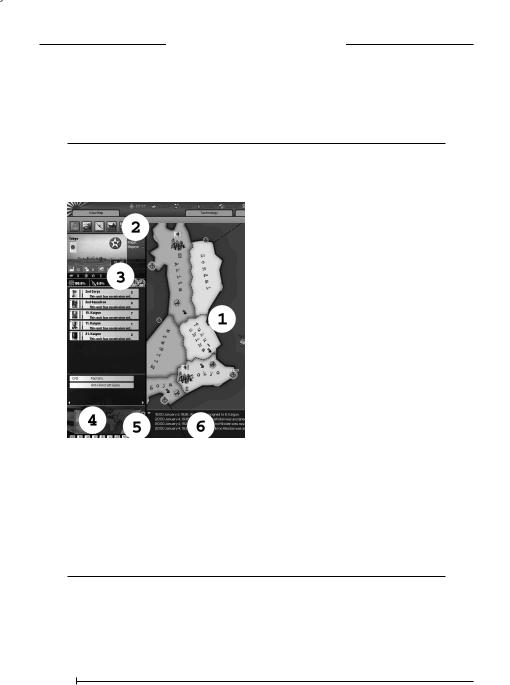
HEARTS OF IRON DOOMSDAY
include an indication in this manual of every instance where these menus are available, but when in doubt, it isn’t a bad idea to give it a try, since doing so will never cause the game to crash or malfunction.
The Main Map Folder
Overview
This is the default starting screen and the folder that you will use most often. It is here that you will view the map of the world, see your troops and that of your your enemy, deploy your units, issue orders to your armed forces, monitor ongoing battles, survey provincial defences and resources, and much, much more.
You can access the main map view by clicking on the View Map folder tab on the Top Bar. The main map interface screen is divided into several important sections:
1.The Main Map: The largest area of the screen, this is where you will see a portion of the world map
and be able to view and select your provinces and units.
2The Hot Buttons: This is a set of six buttons that give you quick and convenient access to your provinces, troops and deployment queue.
3The Information Panel: The information displayed in this area will change depending on what you are doing. Most actions in the Main Map interface involve viewing and often changing something in this panel.
4The Mini Map: This is a small clickable map that displays the entire globe and gives an approximate graphical representation of the current local time of day. It can also be useful for locating your forces around the world.
5The Mapmode Buttons: This is a set of ten small buttons that you will click to change the information displayed on the main map. Some will cause a fairly drastic change of the map display, while others act more as filters.
6The History Log: This is a scrollable running log of game messages and events.
Since the main map and accompanying context-sensitive information panel places just about everything you’ll need at your fingertips during the course of basic play, it is important to know how to navigate it, and how to interpret the information you see there.
Navigating The Main Map
The world is divided into more than 2500 individual provinces and sea zones. There are far too many to be displayed on the main map while still giving you any useful graphical information, so the main map area displays just one small part of the globe at a time.
Sometimes, you will want to view the main map at a very high level of magnification, where only a handful of provinces will be visible, but where it’s easy to see and select your military units. At other times you may wish
24

HEARTS OF IRON DOOMSDAY
to get a less detailed “big picture” of what’s going on, where you can quickly survey several hundred provinces or look at the general location of troops along a front or in a theatre. You can zoom in and out between HoI2’s four different levels of map resolution by clicking on the small “+” and “-” buttons located on the right edge of the Mini Map. You can also use the “+” and “-” keys on your keyboard; both the regular keys and the number pad keys will work.
The Main Map can be scrolled by moving your mouse pointer to any of the edges of your screen. Doing so will cause the map to begin scrolling in that direction until you remove the pointer from the map edge. You can also use the Mini Map to quickly jump to a different area of the world by clicking on the part of the world that you want to view. Another method is to use the Province Hot Button, the first of the six buttons, to jump to one of your nation’s provinces. Simply click on the button, which has a small graphic of a map, and a scrollable list of your provinces will appear in the information panel. Click on one of these to center the map on that province. The next four hot buttons (see below) can also be used to jump to the location of a specific land, air or naval force, or to a combat currently being fought.
Message boxes that appear during play will often include a “goto” button that you can click to take you quickly to the relevant area of the map. If you know the name of the province you would like to go to, you can also press the “?” button on your keyboard and type the name of the province into the box that appears on your screen; remember, spelling is important! Many of the pages in the Statistics Folder include a “hyperlink” that will take you directly to a province when you double-click on its name. That’s quite a few methods…and I’m undoubtedly forgetting some!
Provinces
Each province - and most importantly, who controls it - is the basic unit of measure for victory in HoI2. There is a distinction between “national” provinces, “owned” provinces and “occupied” provinces. National provinces are ones that have historically belonged to a nation for a long period of time and where the population is generally content with being part of that nation. The only time they will become upset with their government is when it takes actions that are not popular in the view of the public. National provinces will be the heart of your economy and provide you with the bulk of your military recruits. Owned provinces do not share this sense of nationality, but have been under a nation’s dominion long enough that only very small pockets of resistance remain to fight for independence. They tend to generate only a modest economic benefit to your nation and are usually not inclined to join your armed forces. An occupied province is one that has only recently come under the control of a nation, almost invariably as a result of a hostile action, and where the public not only resents its new rulers, but will usually try to actively oppose them. These provinces tend to contribute very little to your economy and are not suitable for recruiting purposes.
Not only can provinces contribute vital natural resources or industrial capacity to your nation, but they can also provide additional defences or strategic assets for your military. Even a quick glance at a province on the main map will reveal important information about it, particularly in conjunction with several of the different map viewing modes. Clicking anywhere within a province’s borders will change the display in the information panel on the left side of the screen to provide all the essential details about the province. This is the Province Information Panel.
Province Name
Each province’s name appears on the Main Map and in the top left corner of the Province Information panel.
25
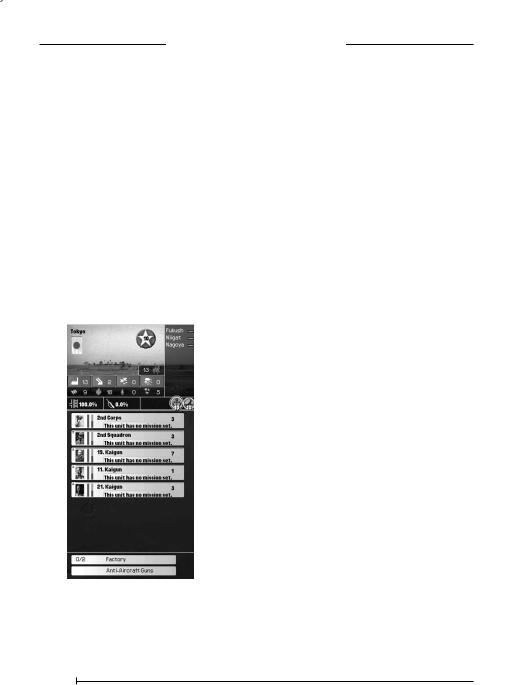
HEARTS OF IRON DOOMSDAY
Hovering your mouse over the province will also display a tooltip with its name, terrain, any special weather conditions, as well as the name of the nation that owns it and controls it. In some mapmodes, the tooltip will also identify the area and region to which the province belongs, which can be important when issuing certain orders for your military.
Province Ownership and Control
The flag of the nation that owns the province appears just below its name in the information panel. You can click on the flag to open the Diplomacy Folder with this nation pre-selected. If this province is currently occupied by another nation, then the flag of the controlling nation will be partially superimposed over the owning nation’s flag. It is the controlling nation that receives any assets from a province.
Victory Point Value
The victory point value of the province, if any, is displayed as a number inside the star on the information panel. National capitals are also identified by a red circle on the main map, and non-capital provinces of particular strategic importance, also known as “key provinces”, will have a red star on them when viewed using the victory point mapmode, and it should be noted that they will not be displayed in other mapmodes. If you have captured most of an enemy nation’s key points, then it will be far more likely to accept your terms for its surrender. If you control all of a nation’s key points, then you may impose extremely harsh terms if you wish, including its annexation and removal from play.
Terrain
A province’s terrain is displayed in the picture on the information panel and is also colour-coded on the main map when using the terrain mapmode. Terrain plays an important role in combat, affecting movement rates and supply as well as the outcome of battles. The following are the various terrain types:
•Plains: Depicted on the map in light beige, this type of terrain is ideal for the movement of all types of units and has no modifying effect on combat.
•Forest: Depicted in green, forest slows down the movement of all units. Defenders gain bonuses in combat, and attacking units with wheels or tracks will have additional penalties reflecting the extra difficulty of manoeuvring.
•Hills: Hilly terrain is displayed in tan and slows down the movement of all units. Defenders gain a small bonus, while attackers, particularly units with wheels or tracks, incur a penalty. One specialised infantry unit, the mountaineers, ignore these penalties.
•Mountain: Mountainous regions are displayed in grey and cause a drastic reduction to movement speed. Defenders enjoy modest bonuses in this terrain, while attacking units are heavily penalised, particularly wheeled or tracked units. Only the special mountaineer units are exempt from penalties, and defending mountaineers have very large bonuses.
•Desert: Yellow regions indicate desert terrain. This terrain is simply not very pleasant to fight in. The performance of both sides will be noticeably and fairly equally reduced, particularly in the case of cavalry units.
26

HEARTS OF IRON DOOMSDAY
•Marsh: Marshes and swampland are depicted in pale green and, as you’d expect, can have a large impact on the movement rates of wheeled or tracked units. Attackers suffer penalties, particularly motorised units, while defenders enjoy a modest bonus. Special marine infantry divisions tend to operate better in these conditions.
•Jungles: Displayed in dark green, jungle terrain is very poor for movement and ideal for defence. Any attacking units that are not on foot will be nearly useless.
•Urban: Urban areas such as large cities are depicted in a yellowish-brown colour. Defenders usually enjoy a modest advantage, since it is assumed that they have had the opportunity to select the optimum defensive positions. Because of winding streets and a multitude of physical obstacles, infantry generally perform better than other unit types in an urban area.
•Water: Lakes and sea zones are displayed in blue on the map. Clicking on them will display only limited information, since they cannot be owned and no structures can be built in them. Note that for the purposes of HoI2, the seaway between the Great Lakes and the Gulf of St. Lawrence is considered impassable to naval and supply vessels, even though this wasn’t strictly the case historically. There are also several narrow bodies of water that may only be used by your ships if you control the adjacent provinces (see Naval Combat section).
•Rivers: Rivers are displayed on the main map as blue lines between provinces and will present a challenge for military forces that attack across them. If possible, you should try to avoid launching such an assault if there is an alternative avenue of approach, although having engineer brigades will mitigate this penalty to a degree.
•Beaches: While many provinces have a coastline, not all of them are suitable sites for the landing of an invasion force on the scale of HoI2. Landing forces from a naval transport, known as invasions, are restricted to provinces that have an additional beach icon of a beige-coloured, crescent-shaped symbol placed on the coastline. These operations are very tricky to accomplish and are quite risky if there is much opposition to the attack.
Weather
Not only does terrain play a role in movement and combat, but weather and weather-related conditions can also hamper your efforts. You can check the weather conditions using the Weather mapmode, and the prevailing conditions are also indicated in the Province Details. Most of the effects will favour the defender over the attacker, although both forces are usually penalized, and the degree of the effect is determined by the severity of the conditions.
•Rain: This is shown on the weather map as a rain cloud. Land forces are only slightly affected by this weather condition. Naval units will suffer somewhat greater penalties and have difficulty locating their targets, and air units will lose almost all of their effectiveness.
•Storm: A storm is a severe form of rain and is shown as a rain cloud with occasional flashes of lightning. Naval vessels are severely hindered in storms and land units will generally have a fairly tough time of it as well. Air units cannot fly missions if their base is experiencing a storm and shouldn’t bother taking off if these conditions exist over their target, since their drastically reduced performance will make the mission little more than a waste of fuel.
•Muddy: This terrain condition is common in certain global regions and is shown in the weather mapmode in brown, while unaffected provinces are shown in beige. This will only affect the performance of land units, particularly any that rely on wheels or are extremely heavy, and unlike most other weather conditions will very strongly favour the defenders in battle.
•Snow: Snowfall tends to affect attacking ground units slightly more than defenders, and will have a very
27

HEARTS OF IRON DOOMSDAY
negative impact on any air missions. Naval vessels will perform poorly as well.
•Blizzard: This is extremely heavy snowfall that will make your aerial units effectively useless, and will also ground them if there is a blizzard over their air base. It has a significant impact on all land and naval battles, as well as movement. Blizzards are displayed as very dense clouds with thick heavy snow falling from them.
•Frozen: Regions will become frozen at certain times of year, reflecting extremely icy and hazardous conditions that will affect movement but only slightly reduce combat capabilities. Defenders have only a slight advantage on frozen ground.
Provincial Borders and Crossing Points
Regardless of the mapmode view you use, provincial borders are shown as a black-dashed line on the Main Map, while national boundaries are traced with red lines. Rivers are depicted as blue lines along provincial boundaries; there are some modest geographic liberties taken with river placement for game design reasons, and only rivers of some significance are taken into consideration. Each provincial boundary is also listed on the right side of the information panel when a province is selected, along with an indication of the type of connection it has with its neighbour, though the label space is limited to the first six characters of the adjacent province’s name. A green dash indicates a border that is not impeded. A blue river icon means that there is a river that must be crossed to move across this border and, if contested by an enemy force, an attacker will incur a river-crossing penalty (for more details, see the Combat section). If there is a unit engaged in battle in an adjacent province, a small red “under fire” symbol will be displayed on the provincial boundary as well. If the boundary is considered impassable, a red line will be displayed. Clicking on one of the border names or icons will change the display to show the Province Details in the information panel for that province instead.
Some very narrow bodies of water may be traversed without the need for naval vessels and are shown using a blue water icon in the boundary listing. Since these crossing points are not displayed on the Main Map, you should pay careful attention to the province boundary listing whenever you are in a province that might have one. If a hostile fleet occupies the sea area, it will prevent you from using or attacking across that narrow strait. If the province you are moving to contains enemy forces, then the combat will be treated as an invasion and is subject to the same penalties as a normal amphibious invasion (see the Combat section for details).
Provincial Assets
The area immediately below the province’s picture provides detailed information about each of its assets, such as its natural resources, industrial conditions (factories, infrastructure and partisanship), its defences, and any other provincial improvements that have been built there. These are described in detail elsewhere, so you may encounter some terms here that you are unfamiliar with, and may need to refer back to after you have read the other sections.
If the province you are viewing is currently controlled by your nation, then several of the areas will be shaded grey and act as Quick Build buttons to allow you to initiate the construction of these items in the province. All province assets may be built using the right-click province menu as well. For province infrastructure, factories, land fortifications and naval fortifications, these are the only two ways to initiate their production. Other assets are built by placing a Production Order for them. This is described in detail in the Production Folder section.
Manpower: This indicates the manpower that this province contributes to its controlling nation’s national manpower pool. Manpower is needed for recruiting and reinforcing your armed forces, although
it may only be drawn from core national provinces and not from owned or occupied territories.
28
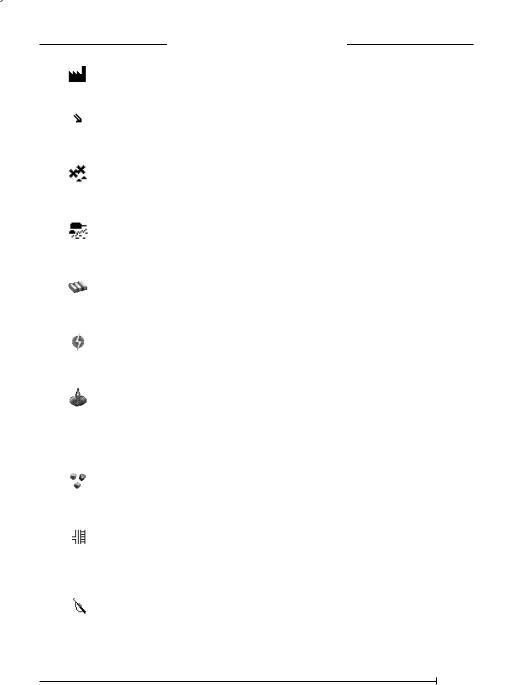
HEARTS OF IRON DOOMSDAY
Industrial Capacity (Factories): This is the number of factories that have been built in this province, each of which provides industrial capacity for the controlling nation. New factories may only be built in
a province that has infrastructure over 33%.
Anti-Aircraft Batteries: This is a province defence that will fire upon any enemy aircraft that venture into the province and do not need to be manned to be operational. This icon will also be visible in the main map, as long as there is at least one AA battery present in the province. This is the only asset that may be built
using all three ordering methods.
Land Fortifications: This is a defensive structure that helps land forces repel enemy attacks that are launched from adjacent provinces. Its size determines how effective a defence it is, but the fortifications must be manned by land divisions and will not assist forces against sea invasions or paratrooper attacks. As
long as at least one fort is present, this icon is also displayed on the Main Map.
Coastal Fortifications: Similar to land fortifications, this is a defensive structure that helps land forces repel an invasion that is launched from the sea. It must be manned to be effective, and it will not provide assistance against attacks launched from a neighbouring province or paratrooper attacks. A matching icon will
appear on the Main Map, as long as there is at least a level one fortification.
Metal: The amount of metal drawn from the province on a daily basis. This amount may be increased by researching appropriate industrial technologies and will either be placed in the nearest resource depot or, if a land supply route can be traced from this province to your capital, in your national stockpile. Metal
is needed by your factories to generate IC.
Energy: The amount of energy drawn from the province on a daily basis. This amount may be also increased by researching the appropriate technologies and will either be placed in the nearest resource depot or, if possible, in your national stockpile. Energy is essential to keep your factories operational and may
be converted into oil if necessary.
Oil: This is the amount of oil drawn from the province on a daily basis. It may be increased by researching appropriate industrial technologies and will either be placed in the nearest resource depot or, if a land supply route can be traced from this province to your capital, in your national stockpile. Oil is vital, as it is
consumed as “fuel” by many units in your military. If you run short of oil, energy may be converted into oil, though the conversion rates may be poor until you have achieve a high technological level. The amount that you may convert on a daily basis is limited to a percentage of your national industrial capacity.
Rare Materials: The amount of rare materials drawn from the province on a daily basis. As with the other resources, this amount can be increased with appropriate technologies and will either be placed in the nearest resource depot or, if possible, in your national stockpile. Your factories need a modest amount
of this resource to remain operational.
Infrastructure: The roads, railways and other infrastructure in a province. Unless this value is 33% or higher, you will not be able to construct factories here and the more infrastructure present, the faster some provincial assets may be built. Infrastructure has a very large effect on the supply efficiency and movement rate of troops located in a province and insufficient levels achieved through poor planning or destruction
by enemy bombing campaigns can have devastating results.
Partisan Activity: This is the amount of partisan activity in the province. Partisans will actively seek to hamper your industry and supply in non-national territories and may even rise in revolt if the opportunity arises. You will need to assign forces to anti-partisan duties to suppress their resistance efforts; garrisons
and MPs are particularly good at this.
29
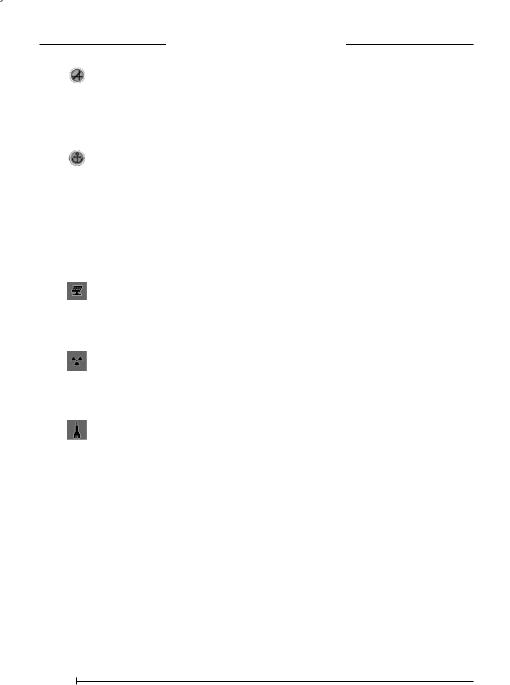
HEARTS OF IRON DOOMSDAY
Air Base: All air units must have a base of operations. The number of individual wings that may be stationed in a province without penalty is determined by the operational size of the base, which may be reduced as a result of enemy attack. If too many wings make simultaneous use of a base, they will experience reduced rates of repair and upgrade and will be slow to regain organisation. On the main map, a base will be blue if it is being used by at least one wing and grey if it is not, although this colour distinction is hidden by the
fog of war.
Ports and Naval Bases: While many provinces have a large enough port for naval vessels to temporarily dock, all military vessels require larger facilities for repairs and refitting to take place. A naval base may support any number of flotillas, but the size of the base determines how efficiently it does so. Repairs to damaged ships will only occur when they return to their assigned naval base. This icon will appear in two different sizes on the main map. A small icon indicates a port, while a larger icon indicates a naval base. If either is coloured in blue, then the port or base currently contains naval vessels, although this too will be hidden by the fog of war. A naval base in a province that you own will remove the fog of war from an adjacent sea area, although it may not necessarily detect any or all enemy naval vessels that go there, since this is subject to your technology. Ports are not displayed in the Province Details, so if you see this icon in the information panel, it
denotes that a naval base has been built here and will also indicate its size and operational condition.
Radar Station: Radar stations provide improved detection of enemy air and naval activities. The air-to-air combat abilities of any aircraft defending the skies over that province will be improved proportionally by the size of the radar installation. A radar site also removes the fog of war from an adjacent sea zone, although
their detection of enemy forces in that zone is limited by the number of stations and by their technology level. You will not be able to see another nation’s radar sites in any province that is hidden by the fog of war.
Nuclear Reactor: This installation might be better described as a nuclear test facility, since it does not provide any power that can be used on a provincial level. Instead, its function is to greatly assist in the research of nuclear technologies and accelerate the testing and manufacture of weapons-grade materials. Nations tend to be secretive about such projects, so these will not be visible if the province is hidden from you
by the fog of war.
Rocket Test Facility: This is the rocketry counterpart to a nuclear reactor, providing a facility for more rapid testing and manufacturing rocket-propelled devices such as flying bombs, rocket bombers, ballistic
missiles and ICBMs. As is the case with nuclear reactors, these are hidden by the fog of war.
Context-Sensitive Information
The upper half of the remainder of the information panel, the large slate-grey area, will display one of two things depending on whether or not you control the province you are reviewing. If you don’t control it, then some basic but essential diplomatic information will be displayed here, as well as the controlling nation’s flag. You may click on the flag to initiate a diplomatic action with that country. If the province is currently under your control, then a complete list of any land, air and sea units that are currently stationed here will be displayed. You can click on one of these list items to select the unit, though this is only one of several ways to do so, and then view its details and issue it orders.
Quick Build Buttons
If the province you are viewing is currently under your control, some of the provincial asset values will be displayed in grey and will also act as Quick Build buttons that allow you to quickly issue a production order for more of that item to be built in this province. For infrastructure, factories, land fortifications and naval fortifications, this is one of only two ways to issue a production order. I will detail this in the Production Folder
30
